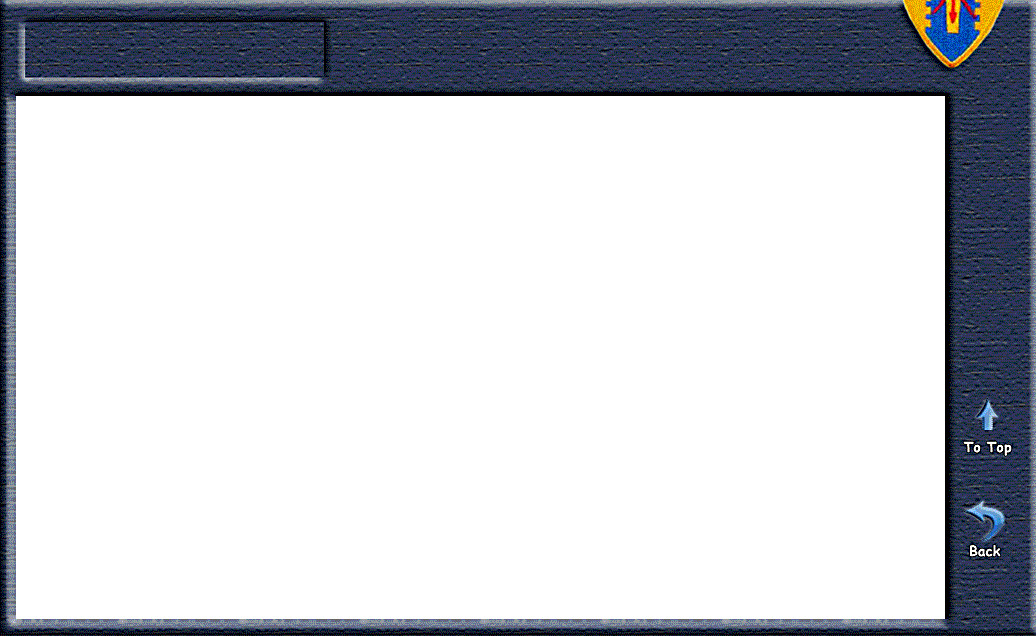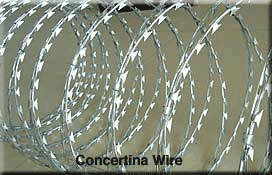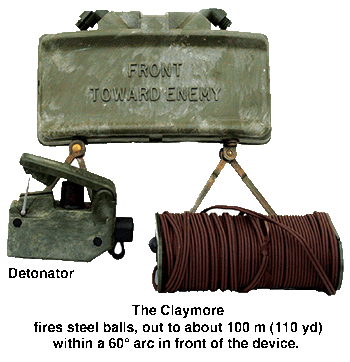

This is an essay that Bob wrote about the high pressure and complex job of setting up, monitoring and tearing down a night ambush site.
At the end of the story is a free verse poem "Ann-Margret's Thrilling Call" by Bob Graham.
Other Centaurs mentioned: Herb Beasley, John Alto, David Horner, and Al Nixon
The Tactical Mine Field: an organized, carefully plotted, and recorded no-man’s land of calculated death. It must be vigilantly watched over day and night as the enemy strives to become familiar, turning the combat obstacle on the creator.
The waist-to-shoulder-high triangles and rows of barbed wire are arranged to impede a massive wave of intruders, forcing them to hesitate in the pre-aligned zones of machine gun fire that can become mined by a stealthy enemy determined to intrude and cause harm to the defender.
 The bales of concertina, restrained spirals of wire with thousands of razor sharp points, rest in the valleys of the picketed rows of ordinary barbed wire that will stop any charge if defended properly.
The bales of concertina, restrained spirals of wire with thousands of razor sharp points, rest in the valleys of the picketed rows of ordinary barbed wire that will stop any charge if defended properly.
But there are weaknesses. Alleyways: for the deadly protection to be maintained, fields of fire cleared of ever-growing grass and undergrowth, and avenues for patrols to pass into enemy ground.
Yes, and a main pathway to the mostly friendly Vietnamese town of Cu Chi nestled against the southern end of the 25th Infantry Division Base Camp. The pathway was a short road, heavily traveled through a formal gate that proudly displayed the Tropic Lightning emblems and a twenty-four-hour-a-day lighted guard post.
Since April 1966, the Cu Chi base camp had never been penetrated by an attacking force. Threatened many times with VC in the wire, but never penetrated. The exception was infiltration via the tunnels of Cu Chi passing in the ground under the wire, and that is another saga that was slowly unfolding. The VC tunnel system deserves separate revelations.
All of these carefully engineered see-through defensive obstacles must be dutifully maintained. Maintenance: to reduce, to control, or eliminate natural growth for clear unobstructed views and field of fire. Maintenance: to eliminate the hazards crafted by the persistent tinkering of the Viet Cong.
This choice task was that of the Aero Rifles of D Troop (Air Cav) and other infantry. These missions, though frequent, were never routine. It seemed uncanny that even though repeated over the same ground, a sequence could produce something new, changed, and not quite like it was before. Lt. John Alto was the man who led his small platoon on the nerve-racking missions, like the one this July 1966 afternoon to “pull maintenance” on Ann-Margret, a key sector on the northern side of the base camp perimeter, followed by a night ambush.
Note: Ann-Margret is a Swedish-American actress, born in 1941. In March 1966, during the Vietnam War, she teamed with entertainers Chuck Day and Mickey Jones to entertain U.S. soldiers during a USO tour of remote parts of Vietnam and other places in Southeast Asia. The troops loved her and named things after her like a bridge, and outpost and a sector of the Cu Chi Base Camp Perimeter.
When briefing the mission, I felt my job was trivial compared to what the Aero Rifles had to accomplish. “After lunch do standard maintenance on the designated sector, Ann-Margret, until dark. Withdraw through the bunker line leaving a squad in ambush.”
"You are to coordinate with the supporting bunkers for direct fire support of your detailed plan. Maintain radio contact on our command frequency.”
I provided the boundaries, marking Ann-Margret with lines on the Centaur Operations map. I passed on information about the VC activity of the night before and previous week. The time check, the artillery coordinated fire support plan, and special instruction that MAJ James Peterson added to provide variation between ambushes was in this case that the stealthily left-behind squad would deploy a couple of M18A1 Claymore antipersonnel mines.
So what was standard maintenance for Platoon Sgt. Horner and his four squads? They needed swing blades to cut grass in the access paths, field of fire, plus the two hand-pumped fire extinguishers they brought from Hawaii to fill with Agent Orange mixture as the weed killer of choice within the barbed wire. Of course they always had the mine detector for a first sweep, just in case a slithering VC managed to crawl undetected to position a booby trap or their own antipersonnel mine in the normal pathways, which were also the bunkers’ primary fields of fire. It was serious business for every last man having this duty. This night the ambush was assigned to SGT Nixon’s squad of eight men.
Lt. Alto issued a PRC-25 radio plus a Claymore mine to each of Sgt. Nixon’s two fire teams for the ambush. The maintenance would be overt so everyone watching could see that this sector of wire was bad news for any attacking force. The ambush would be as stealthy a stay-behind maneuver as could be accomplished with the enemy possibly watching.
How does one accomplish this in full view? In planned positions, just after a battery of artillery’s on-call fire erupted, a designated person would drop into his ambush position. At sunset a light fire team departing from the Centaur Corral would make a low distracting pass along the perimeter, and another one or two would disappear in their ambush positions. During the maintenance activity, the two Claymores were unobtrusively positioned, carefully sighted, and the firing wire unreeled to the location chosen for the two fire team leaders. At dusk, the remainder of the platoon made showy, deceptively, slightly helter-skelter, exits through to the bunker line.
The trap was set; the night descended. Lt. Alto and PSgt. Horner remained in the central bunker with radios tuned to all three operating channels. Both fire team leaders with the M18A1 Claymore firing triggers had positioned themselves to best scan the 60 degree fragmentation zone of death of their deadly mines. Any human in the fragmentation zone within fifty meters had a 30 percent chance of being hit by at least one fragment.
The moon rises in the east over the defensive bunker line, casting shadows in the approaches and fields of fire. Periodically supporting 81mm mortar illumination reveals the shadowy areas with momentary brightness followed by the darkness and frustrating night blindness. It could be twenty minutes before you again see the silhouette of the defensive wire in the ambient light.
In an ambush it does not take long to determine whether you have chosen a comfortable position to lie for nearly ten hours, let alone be alert to detecting movement within your assigned field. Those illumination rounds are both a blessing and a curse. You can confirm that no one is visible in the assigned sector and then, after the flair, night blindness. You are only able to detect a man boldly approaching on his hands and knees. Taking advantage of the flares’ initial pop versus an explosion and positioned in relatively close pairs, you might have been able to trade off observing and avoid night blindness during the short period of the flares’ downward flight.
The tiring cycle of the night seems to last forever. Ten hours is like next week. The lump from a small pocket knife can cause your leg to ache or nearly go numb. An insect bite becomes nastier than reality. It is supposed to be silent, but when you lay in silence the world around can be heard. You search for the slightest sound that does not belong. For microseconds you swear there was a low shadow, a movement beyond real identification, and then nothing follows. Conclusion: Nothing is there, but you instinctively keep closer watch, fixated at the point in nervousness. Then another unusual sound or shadow, and it just goes on and on until the lightness of dawn appears before the morning sun. In the distance behind you the Centaur heliport comes to life with the departure of a light scout H-23 for a morning reconnaissance of Highway One or perhaps a light fire team to check out possible VC positioned road blocks.
Finally the signal, with the distraction of a couple of 105mm howitzer concentrations and the men manning the bunkers beginning to take their morning relief silhouetted by the perimeter skyline behind them. It is time to get the hell out of there. The two fire team leaders begin to roll up the firing wires each had connected to the Claymore detonators. The firing trigger is disconnected and the seventy-five yards of wire are carefully rolled into a ball for the next employment as they intuitively move cautiously to the deadly antipersonnel mine. The first team leader removes the wire from the detonator, scoops up his mine, folds the legs, and is finished.
 A hundred yards away the other fire team leader freezes short of his Claymore, transfixed. With half a dozen steps yet to go, he can see the print on the rounded side facing him. It’s not light enough to read the raised words, but he knows what they say. Instinctively, but quite hopelessly, he flattens to the earth, unable to breathe, his heart pounding. He knows what the raised words say, “FRONT TOWARD ENEMY.’’
A hundred yards away the other fire team leader freezes short of his Claymore, transfixed. With half a dozen steps yet to go, he can see the print on the rounded side facing him. It’s not light enough to read the raised words, but he knows what they say. Instinctively, but quite hopelessly, he flattens to the earth, unable to breathe, his heart pounding. He knows what the raised words say, “FRONT TOWARD ENEMY.’’
The mine had been turned around during the night! For the moment he cannot even look forward, still motionless, breathless, unfocused, and disbelieving.
As he automatically flattens to the earth, the packboard with the PRC-25 slams into the back of his neck, the radio handset clipped to his shoulder harness pressed into his chest is crackling his call sign requesting a situation report.
At the bunker line Lt. Alto and PSgt. Horner observed the dive forward, but no other change can be detected. PSgt. Horner instinctively calls for a situation report. The terse muted reply: ”The Claymore is turned around. I can’t see if the firing wire is still connected to the detonator. Stand by.”
The team leader pulls lightly on the firing wire and it tightens; relieved, he transmits a short, “I’ll take care of this.” It is only a few short steps to reach the Claymore and disconnect the detonator. As he rolls up the loose end of his firing wire it is now tied to the Claymore’s legs, the bare wire end is loose and is not wired to the Claymore detonator! “Damn, that’s not the way I fixed it last night!” Another wire from the detonator now leads off toward the Ho Bo Woods! His mind races, with a quick sweep of his hand he disconnects the detonator. The killing device is now harmless, but was it a second ago? He takes a huge breath, thinks, “Shit! I’ll never know the answer.”
Common sense dictates that he should not pull on that VC wire; it could easily lead to a booby trap. He carefully ties the end to a barbed wire apron stake. He pivots, quickly snatches up the Claymore and strides in defiant steps down the pathways to the safety of the bunker line. Someone else will have to check out that VC wire. This is enough for another day in Vietnam.
LTC Robert L Graham Operations Officer D Troop, Centaurs 1966-67
Copyright April, 2014 Robert L Graham
Ann-Margret’s Thrilling Call
 Ann-Margret, everyone knew of her spectacular arrival
Ann-Margret, everyone knew of her spectacular arrival
Mighty speakers pumped out her popular melodies
Cast thump of drum and her tunes into the night of Vietnam
To the heart of Cu Chi hamlet, deep into Ho Bo Woods
Through the hot humid air, even to the Viet Cong
Ann, the slim, vibrant twenty-six-year-old dancer
Who wows the young warriors during their lonely tour
The actress and her USO troop are protected around the clock
By Centaur helicopter gun teams orbiting into the night
A security umbrella when thousands gathered
A select few dined in Ann’s charming presence
One or two will retell to the very day, of the clear voice from home
Of looking into her eyes as she spoke
Ann-Margret, a deadly protective antipersonnel mine field
Named to honor her graciousness, fame and seductive allure
Lt. Alto, your Aero Rifle mission for today
Tidy up in the heart of Ann-Margret
Clear all patrol paths, locate and mark suspect mines
Remove obscuring blemishes so she is bare
No trip wires or puja sticks, nor VC flares
Patch her apron of tactical wire, her belt of concertina
You will leave an ambush near her heart tonight
One squad left behind will do with a Claymore or two
A battalion of artillery will answer any call from your crew
Your show is to begin after lunch, another good day for all of you
Copyright April, 2014 Robert L Graham